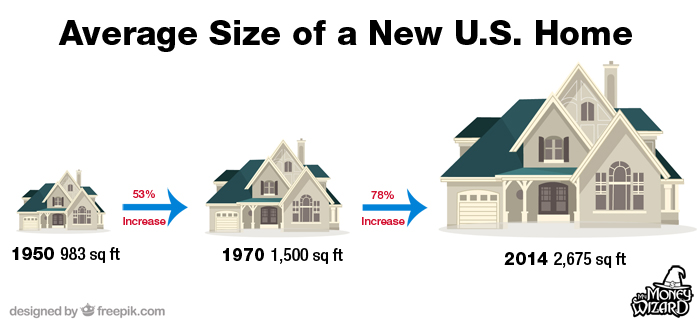

Want to know the first step to getting rich?
Here’s billionaire Mark Cuban, from his creatively titled blog post, How to Get Rich. (Nice one, Mark. Then again, your net worth is 136,666.67% larger than mine, so I’ll shut up now…)
So what should you do to get rich ?
Save your money. Save as much money as you possibly can. Every penny you can. Instead of coffee, drink water. Instead of going to McDonald’s, eat Mac and Cheese. Cut up your credit cards… The first step to getting rich, requires discipline…
You will quickly find that the greatest rate of return you will earn is on your own personal spending… whatever you can save, save it.” – Mark Cuban How to Get Rich
Fascinating, isn’t it? According to one of the world’s most successful businessmen, getting rich doesn’t start with launching a one in a million idea or doubling down on huge risks. (Yes, that casino lied!)
Instead, getting rich begins with a simple move we can all take today: living a little more frugally.
That’s because, no matter who you are, frugal living is the easiest, fastest, and most bulletproof way to strengthen your financial position.
Today’s mega-guide will look at the meaning of frugal living, before diving into some of my favorite frugal living ideas and my best frugal living tips.
What is Frugal Living?
Everyone has their own meaning of frugality, but here’s my favorite:
Frugal living is designing a life that outputs the same level of happiness on a fraction of the cost.” – Some Wise Man.
Read the definition again. (Seriously, I’ll wait…)
The key phrase is the same level of happiness.
This isn’t about turning into a miser, a monk, or sacrificing things that bring true enjoyment.
Picking up pennies until you herniate a disk in your back doesn’t give you the same level of happiness as… not doing that.
Or at least I hope it doesn’t. If it does, then more power to ya, I guess. (You still might want to get that disk checked out though…)
Neither does wasting an entire day washing clothes by hand, just to save a few pennies on electricity. Or alienating all your friends over a couple dollar difference in a shared bill.
Those habits are cheap, not frugal. I’m not into cheap.
I am interested in strategically spending (and saving) in order to live my ideal lifestyle, at a fraction of what everyone thinks is possible.
That’s what we’ll talk about today.
What Frugal Living Means to Me
For me, that’s been about $25,000 a year. For everything.
When I shared this number as a feature story on Yahoo.com, most people didn’t believe it was possible. They assumed I must be living in mom’s basement, never having any fun, and never buying anything. Ever.
They couldn’t believe that in reality, I was living my ideal lifestyle. I was flying around the world month after month, living downtown in a major US city (in my own place, thank ya very much!) eating delicious meals and enjoying events with friends. I was even occasionally splurging on things I really wanted to buy, and I was doing it all for about $2,000 a month. Rent included.
How is this possible? How do you do the same?
The first step: you have to realize that price does not equal value.
You have to distance yourself from judgments about how much things cost, and realize, as Paula Pant famously says, “You can afford to have anything. But not everything.”
This isn’t easy, thanks to a multi-billion dollar marketing machine which exists to constantly bombard us with ideas to spend more money. We are one wallet against thousands of corporations, complete with their armies of millions of employees.
If we want to live frugally, live happily, and ultimately, reach financial freedom sooner than we ever thought possible, we have to rewrite our assumptions about spending.
To do that, we’re employing two mindset hacks.
Frugal Living Hack #1: The Wheaten Eco Scale – The key to saving more money than you ever thought possible
The disbelief of my budget haters doesn’t make Yahoo’s readers completely wacko; there’s actually solid research backing up their feelings.
Jacob over at Early Retirement Extreme discusses the Wheaten Eco Scale. The basic idea of the scale is that we all sit at different “levels” along whatever area of optimization we’re after.
The scale was originally developed for the environmental movement, and the first explanation looked something like this:
- Level 0: Doesn’t care about the environment and does nothing to reduce their waste.
- Level 1: Starts thinking about the environment and might recycle.
- Level 2: Starts their own garden and might even compost at home.
- …Level 6: Never shops at the grocery store, grows all their own food, and probably lives in a community with other environmentalists to reduce their collective carbon footprint to near zero.
Wheaten hypothesizes that no matter where we site on the scale, we feel those people one or two levels behind us look stupid, one or two levels ahead of us look inspiring, and those 3+ levels ahead of us start to look downright crazy.
This makes sense. I mean, I’ve got my own small garden, but you’ve lost me when you start asking that I use my own urine for fertilizer…
Implementing the Wheaten Eco Scale to Spend Less Money
Similarly, what if we changed the scale to various levels of annual spending?
Someone living off $50,000 per year probably finds:
- $65,000 per year is lavish spending.
- $35,000 per year is inspiring.
- $20,000 per year is downright cheap or crazy.
Meanwhile, as I live off ~$25,000 per year, I personally find:
- $35,000 per year lavish.
- $15,000 per year inspiring.
- $5,000 per year death-metal extreme.
What’s interesting is that different people, living in the same country (and as we’ll soon talk about, living relatively similar lifestyles) find the same numbers either inspiring or insane.
The only difference is their current frame of reference.
Recognizing this is the first step to reprogramming your spending levels and starting to spend only on what’s most important to you.
Frugal Living Hack #2: The First Principles Approach – The key to giving yourself a clean slate
Next, we’ll move to this article’s second billionaire – Elon Musk, the founder of the Tesla car company and the possible real life Bruce Wayne.

He’s a good role model here, since he’s famous for his innovative approach to solving problems. When specifically asked about this Batman-like superpower, Elon attributed his problem solving genius to something called the First Principles Approach.
Matt over at Distilled Dollar first introduced me to this idea. Here’s Elon himself explaining the First Principles Approach:
Somebody could say battery packs are really expensive, and that’s just the way it’ll always be because that’s the way they’ve been in the past.
Well, no, that’s really dumb. If we apply that reasoning to anything new, then we wouldn’t be able to get to the next level.
For batteries, historically, it has cost $600 per kilowatt hour. So, it is not going to be much better than that in the future.
First principles would say, ‘What are the component parts that make up a battery? What is the spot market value of each component?’
Okay, so a battery has cobalt, nickel, aluminum, carbon, some polymers for separation, and a steel can.
If we bought each piece on the London metal exchange what would it cost?
Turns out it is only $80 per kilowatt hour.
Clearly, we only need to think of clever ways to combine those materials into the shape of a battery cell and we can have batteries that are much cheaper than what anyone realizes.”
Okay, real clever, Batman. But how does that help me save money?
Implementing the First Principles Approach to Spend Less Money (Step 1)
Most naturally frugal people constantly use Elon’s approach when spending money. We’re just not quite as smart as Elon, so we might not even realize when we’re using it.
For example, when I moved across country for my first “real job” out of college and started apartment hunting, I didn’t say to myself, “Well, the average cost of a one bedroom here is $1,500 per month, so let me look around for something in that range.”
Instead, like Elon, I first asked myself, “What are the component parts that make up a good home for me? What is most important to me in a home?”
It turned out trendiness, granite countertops, and stainless steel appliances didn’t make the cut. A close location to my office, the gym, and a biking trail did. I found all of those features for around $800 a month. About half of what all of my broke friends suggested I needed to spend.
We can apply this concept to every spending and budgeting decision we make.
Tying First Principles to Budgeting (Step 2)
I’ve mentioned before that I believe in a top down approach to budgeting. This is really just another way of implementing the first principles approach.
Rather than say, “Well, the average American saves around 5 percent of their money, so I think I’ll shoot for 10 percent,” the wise man instead looks and asks:
- “What is most important to me?”
- “Which things do I spend money on that make me happy?”
- “What do I spend my money that might be a waste?”
- “Is there a better use for some of this money, like buying freedom?”
With this approach, how much you make is irrelevant to your target spending. You also won’t find yourself mindless throwing away money just because, “It’s within my budget.”
Instead, you’ll have a carefully crafted life where you’re buying exactly what is important to you while strapping yourself to a SpaceX Rocket Ship of Savings. Ready to launch yourself into the weightless orbit of financial freedom.
My 21 Best Frugal Living Tips

At this point, you’re probably thinking, “Enough with the philosophy already! How do I actually live on less??”
Fair enough. So far we’ve gotten as theoretical in here as Stephen Hawking at a physics convention. But there’s a reason for that.
Designing a life that outputs the same level of happiness on a fraction of the cost is more than a few quick tips. This stuff is different for everyone.
The only general rule is that you have to scrutinize your own spending, then and make the personal judgment call on what is actually bringing you happiness, and what is waste.
That said, in analyzing my own frugal lifestyle and the lifestyles of tons of successful readers, I’ve noticed a few common tricks to happily living on a fraction of the average spending.
Frugal Budgeting
1. Adopt the low stress budget
Sure, you can make yourself a strict budget, then stress over 2 cent overages in a specific category. Or, you can take a much more realistic and sustainable approach.
Just start tracking your spending. Then, watch for any areas that stick out and gradually adjust over time.
It’s kind of like the difference between going on a fad diet versus finding healthy foods you actually enjoy eating.
If you want to start tracking your spending the low stress way, I continue to recommend Personal Capital. I’ve also come up with a pretty easy way to track your spending on your iPhone.
2. Understand The Big Three
Did you know the average American spends 70% of their budget on just three things?
In order, they are:
- Housing
- Transportation
- Food
Get those under control, and you’re pretty much set.
See also: The Only 3 Expenses that Matter for Saving Serious Cash
3. Rethinking insurance
Insurance for your health? Got it. Insurance for huge ticket items that would be devastating to replace? Makes sense.
Insurance for your junk, travel plans, pets, one in a trillion legal issues, and maybe even insurance for your insurance (that’s buying life insurance when you’re young, by the way) …now we’re just getting carried away.
If you want to avoid spending a huge chunk of your paycheck every month to ease unlikely fears, you’ll need to remember that insurance companies have to make money somehow. This means that statistically, any insurance policy you sign up for will have you losing money over time.
With this in mind, you should really only insure things that are reasonably likely of occurring, and if they did occur, would leave you so financially ruined that you have no other option.
Relax, it’s not as scary as it sounds. If you’re living a frugal lifestyle, you’ll be saving enough money to afford most of these concerns anyway, in the unlikely event they do happen.
4. Live like your grandparents
Why try to reinvest the wheel?
How about picking up some frugal living tips from the great depression?
When I looked into how previous generations lived, it really put everything into perspective.
Frugal Spending
5. Get paid cash back for stuff you would have bought anyway
I don’t always buy stuff, but when I do, I like to get paid for it.

Cash back programs like Ebates/Rakuten are a fantastic way to earn 1% to over 15% cash back on pretty much every store in existence.
6. When in doubt, buy used.
Chances are, whatever you’re looking to buy has already been bought by somebody else.
I had a good laugh recently, when a family member came to visit our new house. They asked the usual guest questions:
- “I like that couch, where’d you get it?”
- “How’d you find that bookshelf?”
- “Is that a new bathroom vanity?”
I had to stop and laugh at myself when, after the tenth question like this, I realized my answer to every single one was exactly the same. Almost everything in the home came from Craigslist, Facebook Marketplace, or my favorite local thrift store.
It sounds silly, but I’m guessing I’ve saved well over $10,000 in the cost of furniture, tools, etc. just by making “used” my default purchase choice.
7. Buy stuff with gift cards
Sites like Swagbucks will pay you gift cards for everything from searching the internet to watching videos on the internet. Stock pile these for a while, and you can eventually use those gift cards to offset the cost of your next Amazon impulse buy.
8. Grocery shop like a pro
As one of the big three expenses, grocery spending adds up quickly.
I recently shocked the world with how I spent less than $35 a week on groceries.
Okay, shocked the world might be a lie. But the post was popular enough that I published a follow up piece with my 15 best tips for saving money on groceries.
9. About those infamous lattes…
Personally, it seems like a rip off to pay $5 for 25 cents worth of coffee.
I know, blasphemy! Coffee spending might be the most controversial topic in personal finance.
For some people, a daily coffee is one of their great joys. Lady Money Wizard happens to fit that description, but even she recently bought a legit espresso machine so she could start making them at home. She says it’s just as good and even cheaper.
She also picked up a home milk frother, which gives her home drinks that final professional’s touch.
Compared to daily Starbucks, both those buys pay for themselves in less than a month. Plus, with these new secret weapons, those hipster baristas got nothing on the home brew!
10. Reconsider unneeded material stuff
Science has already found a direct link between materialism and depression. In other words, that new car, the upgraded iPhone, and that one-in-a-million souvenir is completely overrated.
I side with science here. Personally, I find most material stuff causes too much clutter, so the most expensive gift shop purchase I’ve made in the past 5 years is a 50 cent post card.
11. Keep your old phone as long as possible
I ran the numbers and figured out that cell phones cost more than cars.
Yeah… I think I’ll keep that iPhone as long as possible.
(Don’t forget that you can always buy refurbished iPhones on Amazon.)
12. Dress like a billionaire to save money on clothes
I hardly spend anything on clothes, and yet, at least according to Lady Money Wizard, I still have style. (Considering the legendary toughness of spouses on their husband’s wardrobe choices, I’ll count this as a big win.)
How do I do it?
I dress like a billionaire. And no, that doesn’t mean a tuxedo everywhere.
For guys, it means dark wash jeans, a clean t shirt, and a nice pair of shoes. (The most commonly worn outfit by the rich and famous, ironically.) Dressier occasions get a clean button down shirt.
Of course, you can purchase all of this stuff at the thrift store. And if that makes you squirm, remember the golden rule of clothes shopping: fit is more important than brand.
Frugal Transportation
13. Win the car buying game
Winning on your car purchase starts before you ever step foot on the lot.
SUVs and Trucks, the two most popular vehicle types in America, lock you into more expensive gas, costlier oil changes, pricier tires, and extra charges for basically everything. You can get a similar yet cheaper experience with hatchbacks.
Whatever vehicle type you decide, you’ll want to negotiate like a pro. Here’s the negotiation strategy I used to buy a nice new car for $13,000.
(Which reminds me, sometimes buying new is actually a better deal than used.)
14. Kill the car payment
Here’s another incentive to win the car buying game. If you purchase a reasonably priced car, you should be able to completely eliminate a car payment from your budget, freeing up hundreds of dollars a month.
15. Drive less.
The IRS estimates that driving costs 58 cents per mile.
Considering the average american drives around 13,000 miles a year, that’s $7,500 just on driving-related expenses.
Every. Single. Year.
That’s nuts!
Cut down your drive time by bunching errands together, biking more, and if all else fails, accept a job closer to home.
As your odometer spins slower, it might as well be a cash machine for your bank account. Cha-ching!
17. Consider becoming a one car household
For the truly dedicated money savers – ditch the car entirely!
If you’re a two car household, depending on your schedules and location relative to work, you may be able to downsize to one vehicle easier than you think.
Look into your own schedules, public transportation options, and remote work arrangements. Just imagine how much you could save without all the gas, insurance, and other vehicle related costs of a second vehicle.
Frugal Housing
18. Win the house buying game
Rule #1) Don’t buy more house than you need
Rule #2) You probably need less house than you think. At least that’s according to new researching showing that nearly 75% of the average home’s square footage goes entirely unused.
Even stranger, the size of homes have increased 172% since the 1950s, without any real explanation.

Don’t fall victim to the trap. Housing is the largest expense for the average consumer, meaning a more frugal home represents the greatest opportunity for savings in the whole budget.
Frugal Entertainment
19. Travel the world on the cheap
Like most millennials, I love to travel. (Typical…)
But I don’t love spending money, which creates a bit of a conundrum.
I’ve balanced the two by:
- Taking advantage of credit card rewards
- Strategically flying on slower travel days
- Looking for cheap authentic experiences rather than overpriced tourist traps.
I talk about even more frugal travel tips in this article published on Business Insider.
20. Don’t forget about books
Nothing’s cheaper than staring at some paper. Even a full-price book can take days to finish, giving you an hourly entertainment cost that puts movies, events, and most other distractions to shame.
Even better, the book section of your local thrift shop can push that hourly cost into the pennies. My favorite thrift shop sells paperbacks for 50 cents and hardcovers for a dollar.
Oh, and of course, the library is always free.
Check out some of my favorite money books from when I first started my frugal living journey.
21. Pick up frugal hobbies (or even hobbies that pay!)
Hobbies range from crazy expensive (looking at you, golf!) to practically free (shout out to tip #20!). And yet, we seem to enjoy them no matter what, or else they wouldn’t be hobbies.
Replace golfing with cycling, or cycling with running.
When there’s cash to be saved, why not choose hobbies on the cheaper side?
Wrapping It All Up – A Simple 3 Step Process to a More Frugal Lifestyle
If you made it this far, I’ve got to congratulate you on reading over 3,000 words on frugality. Not an easy task!
We’ve covered a lot of ground, but frugal living can really be boiled down to a simple, three part process:
- Throw away any pre-conceived ideas you have about what a reasonable budget is. You can live a fantastic life on far less than you ever thought possible, especially if you’ve been listening to mainstream American advice.
- Boil down your spending to a first-principles approach. What is it that actually makes you happy?
- Systematically review what you’re spending money on. Take a look at each major category and decide if you’re leaking money on things that aren’t truly adding to your happiness. Plug those leaks!
If you follow this process, I promise you’ll slash your spending and supercharge your savings.
Good luck!


money wiz- you’re a legend
Haha, not sure what to say to that, but thanks!
Amen!
🙌
Most of these are very easy to implement and I do so already. Living in Orange County, CA makes housing (high rent or housing costs) and transportation (minimal efficient public transportation/high fuel costs) very expensive. Either you live far from work and have inexpensive housing, or living close to work and have expensive housing. Depending on what you do for work and where you work its hard to have it all.
I have to do a lot of balancing. Good thing I grew being frugal. Thrift stores, Goodwill, and discount/clearance sections are my favorite! 🙂
Yeah, California is brutal. Hopefully you get paid more to offset it, and it sounds like you’re doing a good job living the fugal life either way.
Thank you for the tips! Relating to #5, there is another site, Befrugal.com, that I use in addition to Rakuten (formerly eBates). For the stores I shop at, Befrugal usually has high cash back percentages than Rakuten, but it only takes me less than a minute to compare. They also have more frequent cash out times.
Here is a link to sign up for Befrugal if you’re interested: befrugal.com/rs/MKTOQMB/
We both would receive a $10 bonus.
Lily
I hadn’t heard of BeFrugal, I’ll have to check it out. Thanks.
First principles thinking does really free you up from a lot of cost.
I actually do not track my budget and instead ask myself what I really want / need. If I cannot make a strong case to myself for a purchase, then I do not buy it.
The other piece is buying quality the first time. I try to buy high quality items and take care of them. This also helps curb the consumption based mindset.
Because of this, my savings / investment rate is high especially at my income level. This in turn, makes Personal Capital extremely addictive. Watching my investment contributions snowball is really fun 🙂
Haha, I feel you about Personal Capital being addicting! How do you think I’ve kept the net worth updates going for this long?
Love this post!
Thanks!
Excellent read with lots of practical advice throughout. Keep up the great content!
Glad you liked it!!
Hey Money Wizard,
Love the blog! Any recommendation on my golf obsession? I think I spend between $2-3k a year on the hobby, but I really enjoy it. I know you ski, so do you put a restriction on how much you spend for your ski hobby?
Also, could you tell me why you don’t like term and whole life insurance? I recently got married and it seems like a good option to protect my wife if anything happened to me. Any insight would be appreciated.
My “insurance on insurance” line in the article was a reference to single young people buying life insurance because they’re afraid their rates will go up between now and the 5-10 years until find a spouse and start a family. That’s fears playing on fears and never made any financial sense to me. In reality there’s nothing they should worry about or insure against because there’s no family.
Term Life Insurance can make sense for people with families and without a comfortable liquid net worth. Whole Life Insurance is just an awful Frankstein-mixture between Term and a regular investment account. If you want the protection mixed with performance/cash value, just get Term insurance and invest the extra premium in a real investment strategy. (Low cost index funds or similar)
If you really love golfing, I wouldn’t stress about it. Just make sure you’re actually enjoying the splurges and not just falling into a routine. For skiing, I look for discounts wherever I can and then take comfort in knowing I did my best to make it as affordable as possible. Skiing also has the benefit of being a seasonal sport, so each time I go it feels new and exciting.
Thanks! I appreciate the response! Sorry about your cat; It was a really good point you made about the life lesson.
I love to ski. And refuse to buy a lift ticket. I get there early, hike up for 30 minutes to 1 hour, depending how long the trail is. What a good workout. (You’d be surprised all the things I find in the snow that have been dropped from the chair lift) I also pack snacks, hot chocolate in my thermos, and a good lunch. Gas to drive up is my ONLY expense. I usually get a ride!
IRT Insurance, good points; what are your thoughts on life insurance?
I live in my mom’s basement and I’m proud of it because I don’t have a job and make money collecting bottles and cans in California and I get five cents for each one but I don’t pay no taxes I guess you guys don’t no how much energy you can save if the basement is small and underground because usually I don’t have to heat it up in the winter and I doesn’t have a car either but that cost a lot of money and my mom won’t let me drive her car cause I don’t have a license but I consider myself successful. So why you always bad mouthing basement living? It’s great!
This will not work for everyone. But, my frugal housing hack was to buy a duplex and move into one apartment. After I collected the rent and paid the mortgage. My 2 bedroom 1.5 bath apartment cost me $100 per month.
Great Post! I feel like I do a decent job related to most of your tips, however, still struggle with #15… Id also love to ditch my car and have 1 car between my fiancee and I…I feel like this is dependent on where you live and the public transportation options. Right now, it would be a pretty inconvenient since here in Austin the public transportation options kinda suck and both my fiancee and I work on opposite parts of town. If I was able to work from home full time that would work better and I would drive a lot less overall (win win)
Hi Money wizard
Thank you for the great tips,
What would be your advice to convince a partner on some of the tips like buying used ?
“You can’t convince anyone of anything. You can only lead by example and hope they follow.”
Very good , you never to old to learn more about being frugal , wished more mankind takes your tips and advise , but I guess it is not for everyone and some rich ones spend their money lavishly , never think about tomorrow or giving a hand to the not so privlished !
Love this article! I tell people all the time, when you first start on this journey, it is like a frugal diet but then it becomes your frugal lifestyle. It feels good to have discipline and know where you money is going.
Hello, Money wizard
Thanks for these amazing tips, it’s really helpful for us.